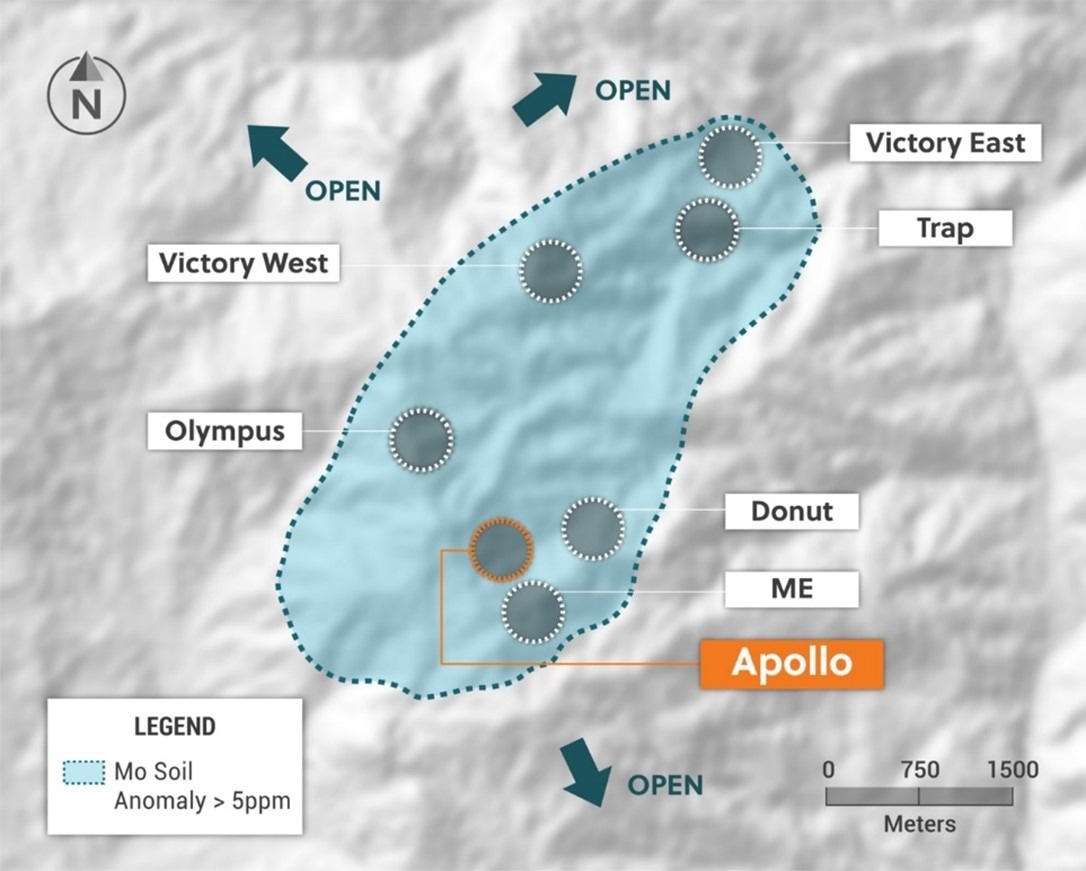Reviewed by Alex SmithJul 27 2022
Collective Mining Ltd. has declared visual observations from three extra holes that have been completed at the Apollo target at the Company’s Guayabales project situated in Caldas, Colombia.
 Plan View of the Guayabales Project Highlighting the Apollo Target. Image Credit: Collective Mining Ltd.
Plan View of the Guayabales Project Highlighting the Apollo Target. Image Credit: Collective Mining Ltd.
Apollo is a newly found high-grade copper–gold–silver porphyry-related breccia where the Company currently declared the assay outcomes for the discovery hole APC-1. This has been sectioned at 87.8 m @ 2.49 g/t AuEq.
Apollo is known as one of eight porphyry-related targets located within a three-by-four-km cluster area produced by the Company via grassroots exploration at the Guayabales project.
As part of its completely funded 20,000+ m drill program for 2022, there is currently the availability of three diamond drill rigs functioning at the Apollo target, with an extra rig being mobilized to the site to commence the Phase II program at the Olympus target in August 2022.
Highlights
- Drill holes named APC-3 and APC-5 were drilled in opposite directions from two divided drill pads to the northeast and southwest respectively to test the persistence of the mineralized breccia earlier sectioned in holes APC-1, APC-1W, and APC-2. Both holes sectioned a minimum of 200 m of mineralized breccia, from 276 m downhole (200 m vertical) in APC-3 and from 252.6 m downhole (135 m vertical) in APC-5. Core obtained from such holes has been sent to the laboratory as a batch and assay outcomes are anticipated in the forthcoming days.
- Drill hole APC-4 aimed at a newly produced breccia target situated nearly to the east of the main breccia at Apollo where a small historical artisanal mine is situated. After passing via unmineralized and weathered material, the hole sectioned 10 to15 m of preferable breccia having overprinting CBM veins. Core logging from this hole has been finalized and half core will be passed on to the assay laboratory for analysis.
- So far, visual observations and outcomes from the first five holes drilled into the Apollo target verify that the primary mineralized breccia has the least strike length of 300 m in a NE-SW direction and expands to a minimum of 400 m vertically below the surface. The target is still open in all directions.
- Mineralization is exceptionally constant alongside the axis of both intercepts and is hosted inside a breccia sulfide matrix comprising pyrite, pyrrhotite, and chalcopyrite (Cu). The breccia clasts are all quartz diorite in composition and this hydrothermal system has been linked clearly to a porphyry system. Furthermore, overprinting carbonate base metal (“CBM”) veins flood the breccia matrix in several locations along the mineralized intervals. As far as the drill hole APC-3 is concerned, zones of sheeted CBM veins were explained over intervals of 10 to 25 m with visible Galena (Pb) and sphalerite (Zn) noted.
- The Apollo target, as specified so far by rock sampling, surface mapping, and copper and molybdenum soil geochemistry, spans an 800 m × 700 m area and additional drilling is scheduled from several locations to continue to extend the mineralized zone.
- Apollo is road accessible throughout the year and is situated inside an elevation range ranging from 1,800 to 2,000 m above sea level. Furthermore, an electrical substation is situated below 1 km from the target area.
The Apollo target continues to expand in size as we complete further drilling. These two new holes outline the robust nature of this mineralized breccia, and we now have three intercepts measuring more than 200 meters in length which are beginning to point to the discovery of a potentially large bulk-style mineralized system.
Ari Sussman, Executive Chairman, Collective Mining Ltd.
Sussman added, “We will continue to be aggressive in drilling Apollo at various orientations and dips to learn the geometry of the system and unlock the potential of this very exciting new discovery.”